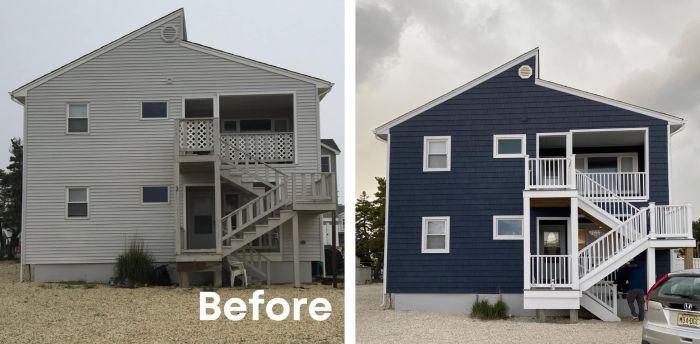Replacing Vinyl Siding Cost: A Comprehensive Guide
Replacing vinyl siding cost is a crucial aspect of home maintenance and renovation projects. Understanding the factors that influence these costs, the preparation required, and whether to opt for professional installation or a DIY approach can make a significant difference in the overall expense.
This guide delves into the various aspects of replacing vinyl siding cost to help you navigate through this process with ease.
Cost Factors
When considering the cost of replacing vinyl siding, there are several key factors that can influence the overall expense. These factors include the type of siding material chosen, the size of the project, the complexity of the installation, and the labor costs involved.
Siding Materials
The cost of replacing vinyl siding can vary significantly depending on the type of material chosen. For example, traditional vinyl siding is generally more affordable compared to premium materials such as fiber cement or engineered wood. While these premium materials may have a higher upfront cost, they often offer greater durability and aesthetic appeal, which can result in long-term savings.
Labor Costs
Labor costs also play a significant role in determining the overall expense of vinyl siding replacement. The complexity of the installation, the size of the project, and the location of the property can all influence labor costs. Additionally, hiring reputable and experienced contractors may come at a higher price but can ensure quality workmanship and a smoother installation process.
Preparation and Planning

Before starting the replacement process for vinyl siding, there are several important preparation steps that need to be taken. Planning ahead is crucial to ensure a smooth and successful siding replacement project. Estimating the quantity of materials needed accurately is also key to avoiding delays and extra costs.
Estimating Material Quantities
- Measure the length and height of each wall where the siding will be replaced.
- Calculate the square footage by multiplying the length by the height of each wall.
- Take into account any windows, doors, or other openings that will not require siding.
- Consider the type of siding and its coverage area per square foot to determine how many panels or pieces are needed.
- Add a buffer of 10% to 15% to account for waste, mistakes, or future repairs.
DIY vs. Professional Installation
When it comes to replacing vinyl siding, one of the key decisions to make is whether to tackle the project yourself or hire professionals. Let's explore the cost implications of each option and weigh the pros and cons.
DIY Installation
- Cost-Effectiveness: DIY installation can save you money on labor costs, as you won't have to pay for professional services.
- Skills Required: You need to have some level of experience and skill in siding installation to ensure a successful DIY project.
- Time Commitment: DIY installation can be time-consuming, especially if you're not familiar with the process.
- Risk of Errors: Without proper knowledge and experience, there is a higher risk of making mistakes that could end up costing more to fix.
Professional Installation
- Cost-Effectiveness: While hiring professionals may come with a higher upfront cost, it can be more cost-effective in the long run due to their expertise and efficiency.
- Quality of Work: Professionals have the skills and experience to ensure a high-quality installation that will last longer and require fewer repairs in the future.
- Time-Saving: Professionals can complete the project more quickly than DIY, saving you time and hassle.
- Warranty: Many professional installers offer warranties on their work, providing you with added peace of mind.
Hidden Costs and Budgeting
When planning for a vinyl siding replacement project, it is crucial to consider potential hidden costs that may arise along the way. By understanding these factors and budgeting effectively, homeowners can avoid unexpected expenses and ensure a smoother renovation process.
Permit Costs
Permit costs are often overlooked but are essential for any home improvement project. Depending on your location, you may need to obtain permits for siding replacement, which can add to the overall cost. It is important to research permit requirements in your area and budget accordingly.
Trim and Accessories
While the focus may be on the vinyl siding itself, don't forget about the additional materials needed for a complete installation. Trim pieces, corner posts, soffits, fascia, and other accessories can quickly add up in cost. Make sure to include these items in your budget to avoid surprises.
Unexpected Repairs
Once the old siding is removed, unexpected repairs may be uncovered. This could include underlying damage to the structure, rot, or mold that needs to be addressed before installing the new siding. It is wise to set aside a contingency fund in your budget to cover any unforeseen repairs that may arise.
Labor Costs
While labor costs are typically included in estimates for professional installation, factors such as customization, additional repairs, or unforeseen complications can lead to increased labor costs. Ensure that you have a clear understanding of the scope of work and any potential additional labor charges to stay within your budget.
Final Thoughts
In conclusion, navigating the costs associated with replacing vinyl siding involves careful consideration of multiple factors. By staying informed about the key elements that impact expenses, planning effectively, and being aware of potential hidden costs, homeowners can achieve a successful siding replacement project within budget.
Answers to Common Questions
What are the key factors influencing the cost of replacing vinyl siding?
The key factors include the size of the project, choice of materials, labor costs, and any additional repairs needed.
Is DIY installation more cost-effective than hiring professionals for vinyl siding replacement?
While DIY installation can save on labor costs, hiring professionals ensures proper installation and may be more cost-effective in the long run.
How can homeowners effectively budget for unexpected costs during a vinyl siding replacement project?
Homeowners should allocate a contingency fund for unforeseen expenses and carefully research potential hidden costs before starting the project.




